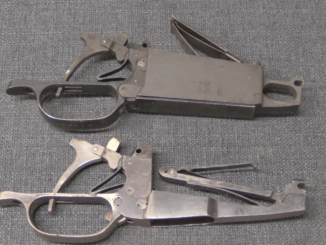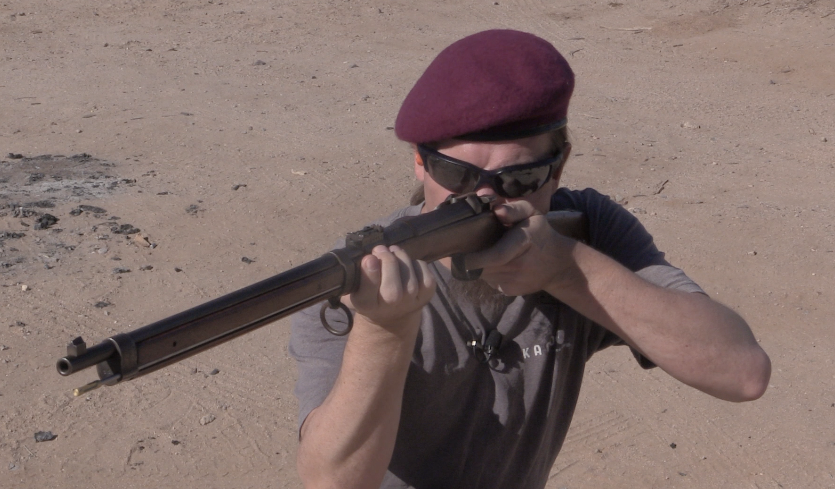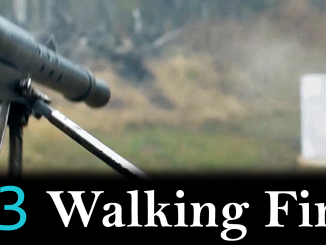This is a conversion of a French 1822 rifle to a single shot bolt action, using a newly manufactured receiver. It is unfortunately not marked with a patent name or date, and I have been unable to find any additional information about it. It actually seems like a pretty solid system, compared to many of the crude and complicated alternatives that many inventors produced.
Related Articles

Bolt Action Rifles
M34: The Berthier Converted to the 7.5mm Rimless Cartridge
With the end of World War One, it was finally possible for the French military to replace the 8mm Lebel cartridge with a modern rimless cartridge, and they wasted no time in doing so. By […]

Bolt Action Rifles
Uruguay’s Forgotten Mauser: the Dovitiis
Uruguay’s Model 1871/94 Mauser conversions – known usually as either Daudetau or Dovitiis Mausers – are a really interesting story of arms history. It begins with Antonio Dovitiis, and Italian tailor and merchant of military […]

Light MGs
Project Lightening Episode 03: Walking Fire
Project Lightening is a collaborative series with Othais and Mae of C&Rsenal in which we test all seven light machine guns and automatic rifles of World War One and put them through a series of […]

I wonder what the strange machining on the firing pin and striker assembly were for? Almost looks like a cam surface. Maybe there is a missing or broken small piece, and it was to prevent firing out of battery, in conjunction with the small “safety” wheel?
They almost look like cock on opening cams. Simply unscrewing the internals from the bolt body doesn’t seem right, there should be some mechanism so the front of the internals so it turns with the bolt body.
That was my thought. Too much machining in there for what it does.
From Charleville Modèle 1777 (smoothbore/flintlock) to Modèle 1777 modifié an IX (rifled+flintlock) to Fusil modèle 1816/1822 and then Mle 1822 conversion to bolt action?
If we take in account prototypes (1717), this weapon system lasted over one century !
And it was used for a lot longer then that in civilian hands. I have the rest of a a 1822T bis which was used during the second world war here in S.W.france to shoot rabbits for the pot.When the germans came into France they had everybody hand in their guns on pain of death. In the countryside there were still stores of black powder for pinfire shotgun shell reloading so they pulled out their great granddads gun which I dont think was confiscated.as it didnt use fixed cartriges
The same thing happened in Canada during ww2 when they stopped making .22 shells. My dad shot rabbits with a flintlock fowling piece that had been brought out from scotland in about 1850 and had been used in the day for shooting passenger pigions on grain stooks
My dad had to do something similar during the war with a percussion shotgun. He had to carefully reuse the caps by filling them with a mixture of ground match heads and gum, which seemed to work well enough, though it would hardly be recommended.
Hello Ian
This conversion is called: Samain.
Réf 85-14
RARE fusil SAMAIN, fabriqué aux Ateliers de LA BUIRE à Lyon. il s’agit de la conversion d’un ancien fusil à percussion modèle 1822 Tbis, en fusil à chargement par la culasse, et tirant la munition du fusil à tabatière modèle 1867. Celui ci a été mis à la dimension d’une carabine de Chasseur, avec la baîonnette de celle ci. Culasse marquée :”ATELIERS DE LA BUIRE A LYON”. canon rayé, hausse de lacarabine de chasseur . ..On distingue les emplacements de la platine et de la contre-platine sur le bois, ceux ci ayabt été re bouchés… Dans sa patine de grenier, très bon état général.
Merci
The following links are some more interesting information that I have found. There were also Springfields that were converted. I picked up a barreled action, and bolt, recently. Which led me to this site, and the others listed. The barrel of mine doesn’t have a rear sight,has a tapped hole for a bead, and has an additional slot in the a action.
https://www.photo.rmn.fr/archive/10-501760-2C6NU0QK0RTQ.html
https://civilwartalk.com/threads/bolt-action-springfield-1861.162598/
Dear Ian
In addition: http://fr.1001mags.com/parution/gazette-des-armes/numero-230-fevrier-1993/page-36-37-texte-integral
TRANSLATION rare SAMAIN rifle manufactured in the LA BUIRE workshops/factory in Lyon France. It is a conversion of the old model 1822T bis(rifled) into a breech loading arm which used the cartrige for the 1867 tabatiere rifle. It was reduced to the dimensions of a carabine for the chasseurs and used the bayonette of that arm The bolt is marked ATELIERS DE LA BUIRE A LYON. The barrel is riffled(1822 Tbis is rifled) and the back site is that of a carabine for chasseurs. You can see where the lock and the counter lock have been replaced with wood inserts As found in an attic with a nice patine and in good shape END OD TRANSLATION
I mentioned in a previous post that I bought an 1822 Tbis that had been converted to the tabatiere system